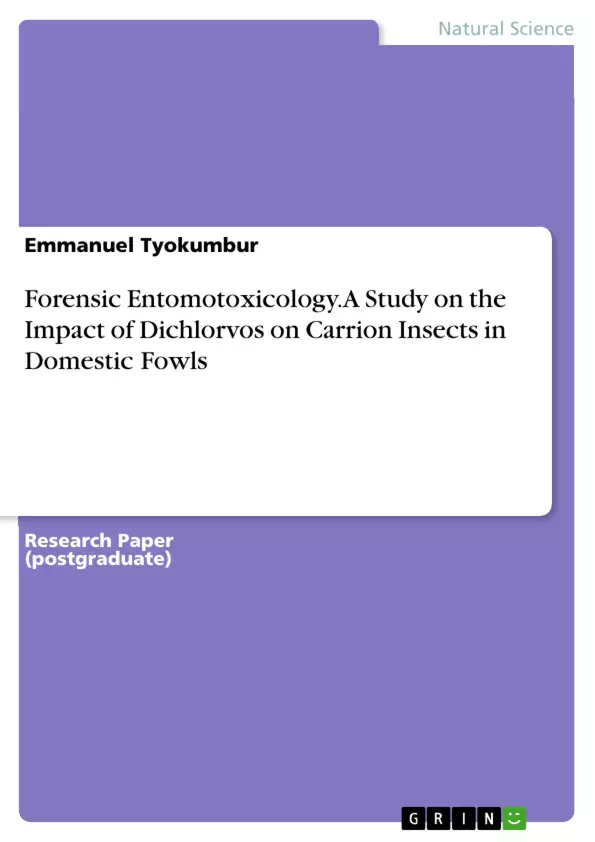The study was conducted on the forensic entomotoxicological evaluation of carrion insects from domestic fowls euthanized with dichlorvos (sniper) insecticide. The research centers on the collection and analysis of insects on the carrions and the impact of the insecticide on them.
It entailed a forensic entomotoxicological evaluation between October and December 2019. The fowls for the study were procured from the main campus of the University of Ibadan. They were then euthanized using 3ml and 5ml of dichlorvos. The adult carrion insects were collected using a sweep net and stored in silica gel. Larvae and pupae were also collected and stored in sample bottles containing 70% ethanol. The temperatures of the environment and the carcasses were measured using an infrared thermometer, while the relative humidity was recorded from a digital hygrometer. The fly families Calliphoridae and Muscidae were the initial colonizers of the decomposing carcass, while Sarcophagidae arrived shortly after the fresh stage of decomposition.
Inhaltsverzeichnis (Table of Contents)
- CHAPTER ONE
- INTRODUCTION
- CARRION INSECTS
- DICHLORVOS
- Aim and Objective of the Study
- CHAPTER TWO
- LITERATURE REVIEW
- Introduction
- Urban forensic entomology
- Stored-product forensic entomology...
- Medico-legal forensic entomology
- Carrion Insect.
- Insect Succession
- Factors affecting fly development.
- Temperature
- Habitat Influence.....
- Types of carrion insect and Arthropods.......
- Calliphoridae.
- Sarcophagidae........
- Muscidae.
- Piophilidae.........
- Silphidae.......
- Cleridae
- Dermestidae.
- Dichlorvos (Sniper)..\li>
- Sniper mode of action.
- Review of Previous Literatures
- CHAPTER THREE
- MATERIALS AND METHOD
- Study Site
- Sample Collection and Processing
- Preparation of Domestic Fowl for Set-up
- Mounting the Fowls.
- Sampling of carrion insect stages
- Sampling for maggot..
- Measurement of larval body length and weight
- Measurement of carcass temperature and humidity..
- CHAPTER FOUR
- RESULTS
- Abundance and species composition of carrion insects on domestic fowl carcass
- Carrion insect succession on domestic fowl carcass.....
- Effect of dichlorvos on the length and weight of Chrysomya albiceps larva.
- Variations in environmental variables at the field site
- PICTURES OF CARRION DECOMPOSITION IN THE STUDY
- CHAPTER FIVE
- DISCUSSION.
- Abundance and specie composition of carrion insects on domestic fowl carcass
- Carrion insect succession on domestic fowl carcass.......
- Effect of dichlorvos and feather on the length and weight of larva
- Variations in environmental variables at the field site
- CONCLUSION.
- REFERENCES.
Zielsetzung und Themenschwerpunkte (Objectives and Key Themes)
This study aims to assess the forensic entomotoxicological effects of dichlorvos (Sniper) insecticide on carrion insects found on euthanized domestic fowl. The research investigates the impact of dichlorvos exposure on the insect fauna associated with decomposition and aims to evaluate the potential of using carrion insects as an alternative matrix for drug detection in forensic investigations.
- The impact of dichlorvos (Sniper) on carrion insect succession and development.
- The influence of environmental variables (temperature, humidity) on decomposition processes.
- The potential of using carrion insects in forensic entomotoxicology.
- The role of carrion insects in the ecosystem services of decomposition.
- The application of forensic entomotoxicology to solving cases of poisoning.
Zusammenfassung der Kapitel (Chapter Summaries)
- Chapter One: Introduction This chapter sets the stage for the study by defining key terms such as entomotoxicology and carrion insects. It highlights the importance of carrion insects in forensic investigations, particularly in cases where traditional biological evidence is scarce. The chapter also outlines the objectives and scope of the research.
- Chapter Two: Literature Review This chapter presents a comprehensive review of relevant literature on forensic entomology, with a focus on carrion insects, insect succession, and the influence of environmental factors on insect development. The chapter also examines the toxicological properties of dichlorvos (Sniper) and its potential impact on carrion insect populations.
- Chapter Three: Materials and Method This chapter details the methodology employed in the study. It describes the study site, the collection and processing of carrion insects, and the measurement of environmental variables. The chapter outlines the experimental setup, including the use of domestic fowl euthanized with different doses of dichlorvos.
- Chapter Four: Results This chapter presents the quantitative data collected during the study. It analyzes the abundance and species composition of carrion insects on domestic fowl carcasses, examines the succession of insect species, and assesses the impact of dichlorvos on the growth and development of carrion larvae.
Schlüsselwörter (Keywords)
Forensic entomotoxicology, Dichlorvos, Sniper, Domestic fowl, Calliphoridae, Decomposition, Insect succession, Postmortem interval, Toxicological analysis, Drug detection.
- Citar trabajo
- Emmanuel Tyokumbur (Autor), 2023, Forensic Entomotoxicology. A Study on the Impact of Dichlorvos on Carrion Insects in Domestic Fowls, Múnich, GRIN Verlag, https://www.grin.com/document/1378517



